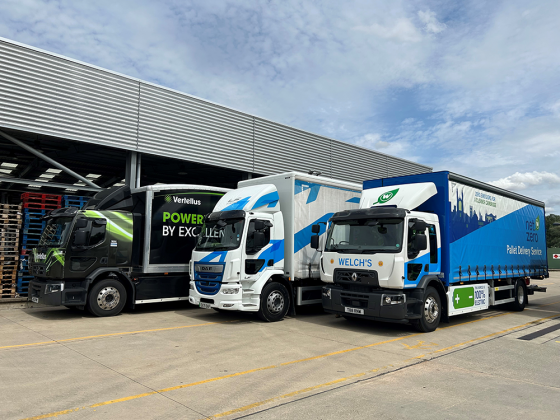Futuristic fuel cell
As the UK’s national infrastructure grows and take-up is given a significant £2m boost, Richard Gooding drives the zero-emission hydrogen fuel cell Toyota Mirai.
 Following on from the recent London Hydrogen Network Expansion’s (LHNE) ‘Tour de M25’ which raised awareness of the benefits of hydrogen fuel cell vehicles (FCVs) as well as the infrastructure surrounding them by setting distance world records around the M25 (GreenFleet issue 93), the government has announced a new £2 million competition to encourage and promote the roll-out of hydrogen-fuelled vehicles.
Following on from the recent London Hydrogen Network Expansion’s (LHNE) ‘Tour de M25’ which raised awareness of the benefits of hydrogen fuel cell vehicles (FCVs) as well as the infrastructure surrounding them by setting distance world records around the M25 (GreenFleet issue 93), the government has announced a new £2 million competition to encourage and promote the roll-out of hydrogen-fuelled vehicles.
Public and private sector fleets can now get a discount of up to 75 per cent off the cost of zero-emission fuel cell electric vehicles by submitting bids to the Fuel Cell Electric Vehicle (FCEV) Fleet Support Scheme by 4 July 2016. Local authorities, fire brigades, health trusts, police forces and private companies can bid for the funding to add hydrogen-powered vehicles to their fleets. In addition, a new publicly‑accessible hydrogen refuelling station has just opened at the National Physical Laboratory in Teddington (see panel), Middlesex. With an increasing number of hydrogen-fuelled vehicles on offer from major motor manufacturers, hydrogen is slowly ramping up to challenge electricity as a viable alternative fuel. One of the hydrogen-powered cars available in the UK for fleets is the Toyota Mirai, and GreenFleet was invited to Toyota’s UK HQ to drive it.
2016 World Green Car
Recipient of the 2016 World Green Car award, the Mirai is taking advantage of the growing national infrastructure in this country and the UK is one of the first European markets to receive the car. Early fleet customers who are already enjoying the benefits include hydrogen energy company ITM Power, Transport for London, and private hire business greentomatocars.
Launched in December 2014, the Mirai is one of the cars eligible for the UK government’s Office of Low Emission Vehicles Plug-in Car Grant. Sales projections are modest, with 15 examples thought to take to the UK’s roads this year, up from 12 in 2015. Over 1,500 orders were received in Japan during the first month of sales, and Toyota has ramped up production to a total of 2,000 in 2016, rising still further to 3,000 in 2017. Toyota expects customers to come from the commercial and public sectors, as well as from the hydrogen industry itself.
In the UK, the Mirai is available in just one high-grade specification. At £66,000 on‑the‑road (not including subsidies), Toyota’s fuel cell challenger isn’t cheap, but as the technology gets more widespread, the cost may well reduce. Toyota UK states that the car is available for sale or for contract hire or lease, with packages available from £750 per month, on a four‑year, 60,000 mile scheme. That monthly cost includes full servicing, tyres and fuel. A further dedicated ‘Mirai Companion’ package includes a dedicated 24/7 concierge service, a journey‑planning app, as well as a five‑year ‘premium’ roadside assistance scheme.
Avantgarde appearance
As befits the technology which powers it, the Mirai has an avantgarde appearance. It certainly stands out as something different, and there are references to the new Prius in some elements of its looks. Styled more with form in mind as opposed to function, the gaping front bumper vents feed in air to cool the powertrain. A sedan bodystyle was chosen to differentiate the car from SUVs with the same technology, even if the hydrogen components were harder to package in a saloon shape. Toyota says others will follow.
Those components include the electric 154bhp motor from the Lexus RX450h hybrid, a pair of 700 bar high-pressure hydrogen storage tanks, a fuel cell boost converter (to convert the hydrogen to electricity) and a nickel-metal hydride battery. As with all hydrogen fuel cell vehicles, the Mirai emits nothing more than water from its ‘exhaust’ (a hole in its rear underbody cladding).
With all the major power unit components mounted under the floor of the car, the Mirai has a low centre of gravity which aids handling as well as reducing body movements. And don’t question safety –the carbonfibre reinforced plastic hydrogen storage tanks can withstand a 150-tonne load for strength and have undergone seven individual tests to prove their impregnability. Even though Toyota has released 5,500 patents relating to hydrogen technology, it still makes the tanks itself.
Relaxed experience
To drive, the Mirai is as conventional as its appearance is unusual. As with the Hyundai ix35 Fuel Cell and many electric cars, a relaxed experience is enjoyed thanks to the lack of noise. There’s more whirring than a traditional EV, the numerous pumps and systems shuffling the car’s power, but with a 342-mile range, anxiety is a thing of the past.
On the move, the Mirai doesn’t feel its 1,800kg weight and there’s nimbleness helped by that low centre of gravity. With 247lb ft/335Nm of torque, the mid‑sized fuel cell car picks up speed really quickly, with 0-62mph coming up in 9.6 seconds. Regenerative braking features, but on our brief drive seemed less effective than that of a more traditional EV.
Like the exterior, the cabin has hints of the new Prius such as the Hybrid System Indicator, and it’s a nice to place to be with a premium finish, partly due to the car’s high list price. The ‘H2O’ button lets the driver purge the water produced by the hydrogen conversion process. The car automatically releases it at regular intervals, but the self-purging is useful if the car is garaged for example. Toyota states that 0.8 litres of water is emitted per 6 miles (10km). ‘Fuel consumption’ is 0.76kg of H2 used for every 100km on NEDC cycle.
Committed to fuel cell technology
Toyota is committed to hydrogen fuel cell technology, and started development work on projects which have resulted in the Mirai over 20 years ago. Toyota (GB) PLC president and managing director, Paul Van der Burgh, said: “The opening of ITM Power’s new filling station is an excellent example of how a coordinated hydrogen fuel infrastructure is successfully being developed in the UK. We are pleased to continue our support for the wider provision of hydrogen fuel outlets, which will encourage increased customer uptake of zero-emission hydrogen fuel cell vehicles.”
Further Information
www.toyota.co.uk






